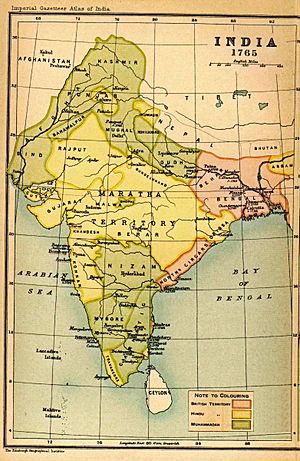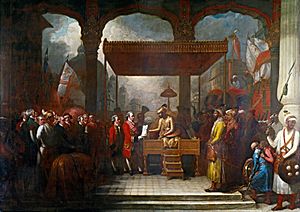Great Bengal famine of 1770 facts for kids
Quick facts for kids Great Bengal Famine of 1770 |
|
|---|---|

India in 1765, showing the major towns in Bengal and the years in which they had been annexed by the British
|
|
| Country | Company rule in India |
| Location | Bengal |
| Period | 1769–1771 |
| Total deaths | Between seven and 10 million in conventional estimates |
| Observations | Policy failure and drought |
| Relief | Attempts to stop exportation and hoarding or monopolising grain; 15,000 expended in importation of grains. |
| Impact on demographics | Population of Bengal declined by around a third |
| Consequences | East India Company took over full administration of Bengal |
The Great Bengal Famine of 1770 was a terrible time when many people in Bengal and Bihar suffered from extreme hunger. It happened between 1769 and 1770. Millions of people were affected. This famine took place when Bengal was ruled by two groups at the same time. The East India Company had the right to collect taxes. But the Mughal governor, called the Nawab of Bengal, still managed the day-to-day running of the area.
The main reasons for the famine were bad harvests in 1768 and 1769. A smallpox outbreak also made things worse. The East India Company had allowed others to collect taxes. This created uncertainty, which likely made the famine's effects more severe. Other problems included grain merchants stopping food loans to farmers. Also, the Company bought a lot of rice for its army. Plus, some Company workers and their Indian helpers created local monopolies on grain. This meant they controlled all the grain.
By the end of 1769, rice prices had doubled. In 1770, they tripled again. In Bihar, armies constantly moving through the dry countryside worsened the situation. The East India Company did little to help. They did not offer much direct relief. They also did not lower taxes, even though people were starving.
By the summer of 1770, people were dying everywhere. Even though the monsoon rains came, they brought diseases. Many weak people became sick and died. For several years after, piracy increased on the Hooghly river. Empty and overgrown villages were a common sight. The number of deaths was not the same everywhere. North Bengal and Bihar suffered greatly. Central Bengal was moderately affected. Eastern Bengal was only slightly affected. The eastern part of Bengal, with more water, recovered faster.
Between seven and ten million people died. This was about a quarter to a third of the region's population. About a third of the farmland was no longer used. Some experts think these numbers might be too high. This is because there wasn't good population data in 1770. Still, the famine completely changed traditional life in the affected areas. It was especially bad for people who grew mulberries and cotton. Many spinners and weavers died because they had no food. The famine quickly ended the dual rule in Bengal. The Company soon became the only ruler. Its impact was felt for a long time. A century later, it became the topic of a famous novel called Anandamath.
Contents
What Was It Called and Where Was It?
The Bengali name for the famine is Chiẏāttôrer mônnôntôr. This name comes from the Bengali calendar year 1176. The Bengali word means "famine."
The famine mainly hit the modern Indian states of Bihar and West Bengal. But it also reached into Orissa and Jharkhand. It also affected parts of modern Bangladesh. The worst-hit areas were Central and Northern Bengal. This included Tirhut, Champaran, and Bettiah in Bihar. South-East Bengal was not harmed. It actually produced extra food during the famine years.
Why Did It Happen?
The famine happened in Bengal. At that time, Bengal was ruled by the East India Company. Their land included modern West Bengal, Bangladesh, and parts of other states. Before this, Bengal was a province of the Mughal empire from the 1500s. It was ruled by a nawab, or governor. In the early 1700s, the Mughal empire started to fall apart. The nawab then became mostly independent.
In the 1600s, the English East India Company was given the town of Calcutta. This was given to them by the Mughal Prince Shah Shuja. Over the next century, the Company gained special trading rights in Bengal. They became the most powerful group there. In 1757, at the Battle of Plassey, the East India Company defeated the nawab Siraj Ud Daulah. After this, they took control of large parts of Bengal. In 1764, their military power was confirmed at Buxar.
The treaty after this battle gave them the right to collect taxes. This was known as dewan. The East India Company then became the real ruler of Bengal. Besides making money from trade, the Company got tax rights in 1764. Within a few years, they increased the amount of land tax they collected by about 30%.
Problems Before the Famine
The famine happened after many smaller food shortages. These shortages had affected Bengal since the early 1700s.
In 1768, the monsoon rains failed in Bengal and Bihar. This led to a partial crop shortage. Market prices for food were higher than usual in early 1769. When the usual rains came in 1769, things got better for a short time. Grains were even sent to Madras Presidency. But by late September, the situation was bad again. It looked like a drought was coming.
Famine and Company Actions
On September 18, 1769, a local official named Mohammed Reza Khan told Harry Verelst about the "dryness of the season." Verelst was the President of the Council at Fort William. In the same month, another official, John Cartier, warned London about the coming famine. A century later, a historian noted this was the "only serious warning." Other letters from that month talked about losing tax money, but not about the famine itself.
By October 23, food was very scarce in Murshidabad. This made the Council buy a lot of rice for its army as an emergency. By late December, food prices had risen sharply. Western Bengal and Bihar were also in a very bad state.
On December 7, local leaders suggested a fair way to collect grain from farmers. The Council did not reply. On January 25, 1770, Cartier suggested lowering land taxes by about seven percent. This was for the areas suffering the most. Ten days later, Cartier changed his mind. He noted that taxes were still being paid despite the hardship. On February 28, the Council suggested being gentle with farmers who couldn't pay taxes. This was because of the bad harvest. But no real relief plan was made by February.
There were no rains, and the spring harvest was small. The Council decided to increase taxes by 10% to meet their goals. Grain prices kept rising all year.
By mid-May, the distress had turned into a full-blown famine. There was mass starvation, begging, and death. Food prices went sky-high. The region ran out of money to buy the little food available. Trade almost stopped. Khan noted that thousands of people were dying daily. Fires were common, and water tanks were empty. These terrible conditions lasted for about three months.
What Was Done to Help?
The Company did little to truly help. They did not lower taxes or make big relief efforts.
In October 1769, the Company asked for storehouses to be built. Officials were told to stop people from controlling all the trade. They also told farmers to grow "every sort" of dry grain possible. These orders mostly failed. Many Company officials and their Indian helpers used the famine to create grain monopolies. This meant they controlled all the grain.
On February 13, Khan and Becher suggested opening six rice distribution centers. These centers would give half a seer of rice per person per day. This plan was approved. The Council paid about 46% of the cost. The rest was paid by the Nawab and other rich people. One center was opened at Reza Khan's palace. This idea was later used in Calcutta and Burdwan. About 3000 people were fed every day. Rice was also given out in other towns. In total, the Company arranged about 4000 pounds of rice over six months.
People who worked for the Company or the local government were especially helped. One official got a lot of rice from Barisal. This rice was sent to Company troops and their families.
Areas where more than twenty thousand people died each month received small money packages. Rules were made to stop exports and imports to control prices. But these rules only made things worse. The region had no money to buy the scarce food. Trade effectively stopped.
Deaths, Moving Away, and Fewer People
How Many Died?
In May 1770, the Company estimated that about one-third of the population had died. This was about ten million people. Later, an official named Becher said it was about three out of every eight people. On July 12, Becher claimed that 500 people were dying in Murshidabad every day. He said conditions were much worse in the countryside.
Diseases like malaria and cholera also caused many deaths. A smallpox outbreak happened at the same time as the famine. It was very severe. Even the Nawab of Murshidabad died from it.
Modern Studies
Most modern experts have used these death figures. However, some historians like Rajat Dutta say these numbers are "too high." He suggests a lower number of about 1.2 million deaths. This would be about 4-5% of the population. Tim Dyson also agrees that the numbers might be too high. He finds the "popular" figure of ten million, which means a huge increase in deaths, "hard to believe." But Dyson does not give his own exact estimate. Experts point out that Bengal had little population data outside Calcutta. Also, many farmers moved to better areas.
What Happened After?
The 1770 monsoon rains brought some small relief. But they also showed how many people had died. A letter from the Council sadly noted that many "hard-working peasants and manufacturers" had been wiped out. The next year, when the drought ended, most of the land had no farmers to work it.
Lasting Impact
The famine had a lasting impact on the economy and culture. A century later, it became the topic of a very important novel. This novel was called Anandamath by Bankim Chandra Chatterjee.
See also
 In Spanish: Gran hambruna de Bengala de 1770 para niños
In Spanish: Gran hambruna de Bengala de 1770 para niños
- Famine in India
- Timeline of major famines in India prior to 1765
- Timeline of major famines in India during British rule
- Bengal famine of 1943
- Deccan famine of 1630–1632




